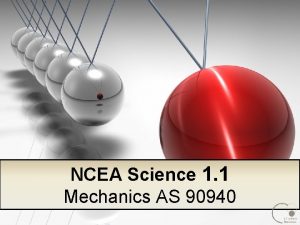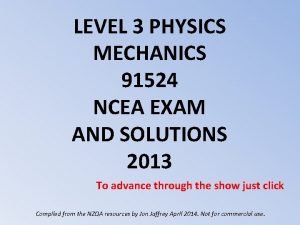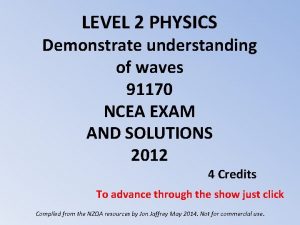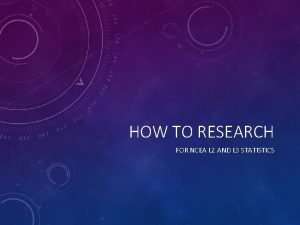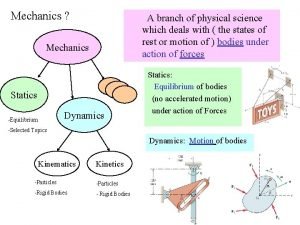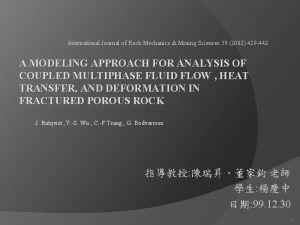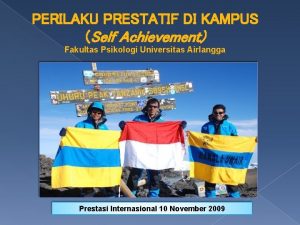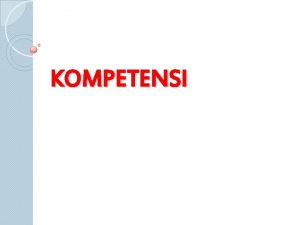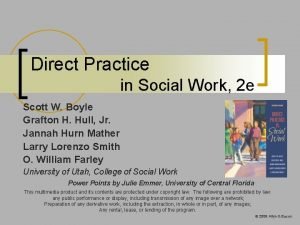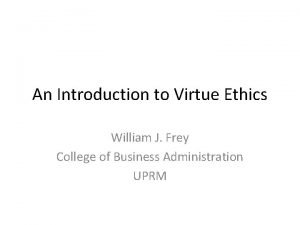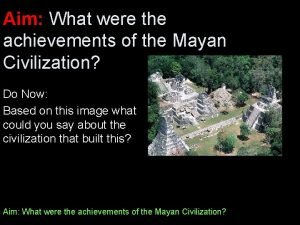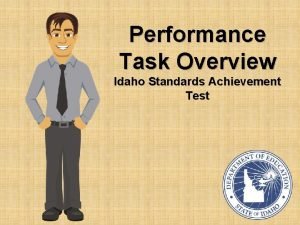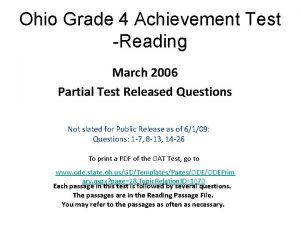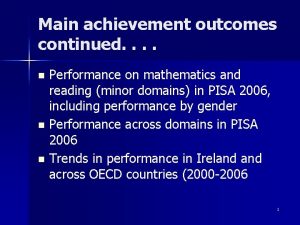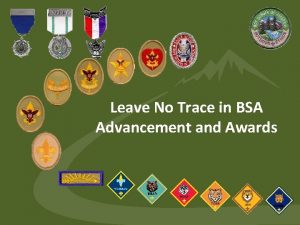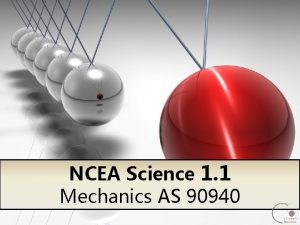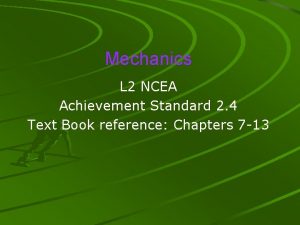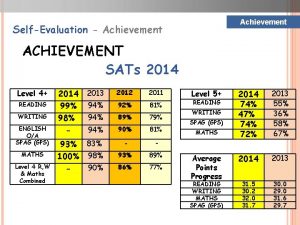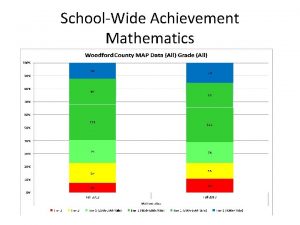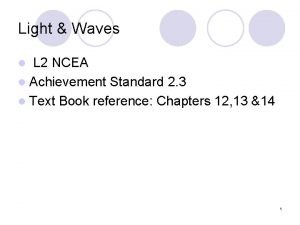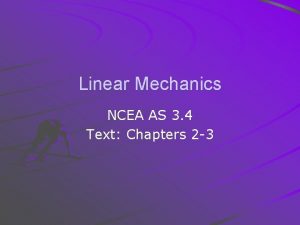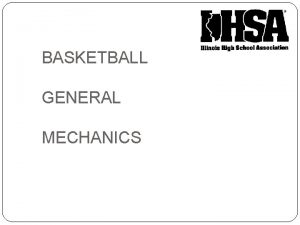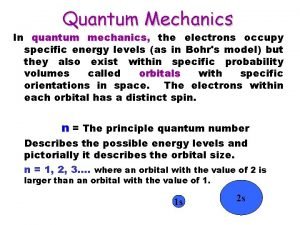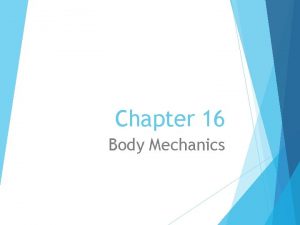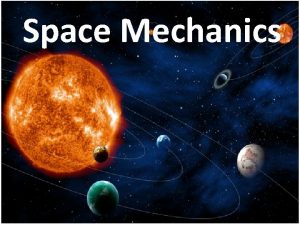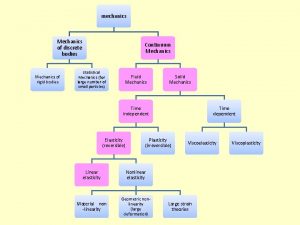NCEA Science 1 1 Mechanics AS 90940 Achievement






































































- Slides: 70

NCEA Science 1. 1 Mechanics AS 90940

Achievement Criteria AS 90940 Aspects of mechanics will be limited to a selection from the S 1. 1 following: q Distance, speed, interpretation of distance and speed time graphs, average acceleration and deceleration in the context of everyday experiences such as journeys, sport, getting going. The relationships . q Mass, weight and the acceleration due to gravity, balanced and unbalanced forces, in the context of everyday experiences such as being stationary, moving at constant speed, accelerating. The relationship. q Force and pressure in the context of everyday experiences. The relationship . q Work and power, gravitational potential energy, kinetic energy, and the conservation of mechanical energy in free fall situations in the context of everyday experiences such as sports performance, dropping things, tossing balls. The relationships

Definition of motion Objects that move from one point of space to another over time are said to have motion. Examples include a tortoise slowly moving across the ground or a bullet moving fast after it has been fired from a gun. Objects that remain at the same point of space over a period of time are called stationary. Examples include a person sitting still on a chair or a parked car.

Measurements of motion Speed is a measure of the distance travelled over the time taken. The more distance covered by an object during a given time, the faster the speed it is moving. In this unit we use the term velocity to mean the same thing. Constant speed occurs when the object travels the same amount of distance at each even time period. When we travel on an object moving at a constant speed we do not feel movement for example travelling in an airplane. Only when we observe other objects moving at a different speed to us do we notice that we are moving. v=d/t v = velocity (ms-1) d = distance (m) t = time (s)

1 b Measuring Motion in Science Quantity Unit Symbol Equipment used Distance Kilometre km odometer Metre m Metre ruler millimetre mm Hand ruler Hour hr clock minute min watch second s Stop watch Time

Converting measurements Quantities are often measured in different scales depending upon what is most appropriate for the original size. In Science (and Mathematics) we use common prefixes to indicate the scale used. We sometimes want to convert scales from one to another to compare data or to place the measurements into equations. Prefix Scale Kilo = 1000 Centi = 1/100 th Milli = 1/1000 th So 1 kilometre = 1000 metres 1 metre contains 100 centimetres 1 metre contains 1000 millimetres To convert from metres to kilometres divide by 1000 To convert from kilometres to metres multiply by 1000 Time is measured in “imperial units” 1 hour has 60 minutes and 1 minute has 60 seconds therefore 1 hour has 3600 seconds

Ba Kn ck ow gro le un dg d e Errors may occur in measurements may be reduced by taking the average of a number of readings When collecting and measuring data in investigations, such as that for calculating speed, errors can occur. This may be due to the measuring instrument and the way it is used. Data can also be recorded incorrectly. Repeating the investigation a number of times and averaging out the measurements can help reduce random errors. This value is called the mean.

Calculating speed using triangles Triangles can be used to calculate speed, distance or time. Cover the part of the triangle you wish to calculate and multiply or divide the remaining two values.

Ba Kn ck ow gro le un dg d e Speed and Velocity measures the speed of an object and the direction it travels. Two objects can have the same speed but different velocities if they are not travelling the same direction. An object can have a constant speed but its velocity can change if it does not travel in a straight line. This car has a change in velocity because it is traveling around a corner even though it has constant speed.

2015 Speed - NCEA Case Study Question 1 a: Chris and Ian were jumping off different platforms into a pool. It took Chris 0. 60 s to reach the water once he had jumped from the 2 m platform. Calculate his average speed. Achieved Question

acceleration aave=∆v/∆t a = acceleration (ms-2) v = velocity (ms-1) t = time (s) acceleration = change of velocity change in time taken The units for Acceleration depend on what velocity and time are measured in. If time is measured in seconds (s) and velocity is measured in metres per second (ms-1) then the units for acceleration will be metres per second (ms-2)

Acceleration is a change in velocity Objects that have a change in velocity are said to have acceleration. An increase in velocity or a decrease in velocity (deceleration) are both types of acceleration. A change in direction while travelling a constant speed is also acceleration. We notice when we are travelling on an object that is accelerating by experiencing a change in gravity or G-force. 12

Ba Kn ck ow gro le un dg d e The Earth accelerates around the Sun The Earth travels at a constant average speed around the Sun (the speed varies slightly due to the elliptical path) and yet it is accelerating. This is because the direction that the Earth is travelling is constantly changing as it moves around the sun. The gravity force from the sun acts on the Earth and causes a change in velocity or acceleration. The Earth’s speed is fast enough so that it does not spiral into the Sun but not so fast that it continues in a curved line away from the Sun. Satellites including the Moon also accelerate around the Earth. If the Speed of a satellites falls beyond a set limit then it will fall to the Earth.

Interpreting Distance/time graphs Distance verses Time graph Distance (y axis) and time (x axis) data can be plotted on a graph to show patterns and compare speeds. The steeper line on the left shows student A has a faster speed than student B. A straight diagonal line indicates constant speed. A straight horizontal line indicates the object is stationary.

Interpreting Distance/time graphs A distance time graph can also show acceleration with a curved line (blue) because at each time interval the distance travelled becomes larger and larger. Changes in speed are also shown with a combination of diagonal and horizontal lines (red). We only find curved lines on a Distancetime graph this year

Velocity (speed) can be calculated from a Distance-time graph B A Make sure the part of the line you are using is straight A distance - time graph can be used to calculate speed (velocity). The coordinates of a straight line in the graph are taken (for example from A to B) by projecting back to the x and y axis. To calculate the value for time find the difference between t 1 and t 2 by subtracting the smallest value from the largest value. This will be your ∆ time. Repeat to find distance on the y axis. This will be your ∆ distance. Place both values into your formula to calculate speed (velocity) v = ∆d/ ∆t

Calculating acceleration from speed/time graphs A velocity time graph can show acceleration with a diagonal line. Constant velocity is shown with a straight horizontal line. Values can be taken from the graphs and used to calculate acceleration. The blue line shows a velocity of 10 ms-1 travelled in 2 seconds. The acceleration would therefore be: a = ∆v/ ∆t = 10/2 a = 5 ms-2

Interpreting Motion/time graphs

2015 Motion Graphs - NCEA Case Study (Part ONE) Question 2 c(i): The speed-time graph shows the flights of two birds. Use the graph to explain which bird has the greater acceleration in the first 3 seconds. Achieved Question Bird B has the greater acceleration – the gradient / slope of the line is greater. Bird A has an acceleration of: Bird B has an acceleration of:

2015 Motion Graphs - NCEA Case Study (Part TWO) Question 2 c (ii) : In 16 s, Bird B travelled 121. 5 m. How much further did Bird A travel in the same time? Show all working. Bird A travelled: (A) 0 – 4 s: (B) 4 – 14 s: (C) 14 – 16 s: Total distance = 130 m So Bird A has flown 8. 50 m further. (130 – 121. 5 = 8. 50 m) Excellence Question

2015 Motion Graphs - NCEA Case Study (Part ONE) Achieved Question 3 a : The distance-time graph below shows the journey of a rowing boat in a race. Describe the motion of the boat throughout the journey. No calculations required. A: Acceleration / increasing speed B: Constant speed /steady speed C: Decelerating / decreasing speed D: Stationary / stopped/at rest (NOT stopping or coming to a stop)

2015 Motion Graphs - NCEA Case Study (Part ONE) Merit Question 3 b : During the first 30 s of the race, the rowers’ speed changed from 0. 0 m s– 1 to 8. 3 m s– 1. During this time they covered 125 m. The total mass of the rowers and the boat is 140 kg. (i) Calculate the boat’s average acceleration during the first 30 seconds. Show your working.

2014 Distance / time graph - NCEA Case Study Q 1: The cyclists journey was plotted on the distance / time graph below. Describe the motion of the cyclist in each of sections A, B, C and D Section A: Increasing speed / accelerating Section B: Constant speed Section C: Decreasing speed, decelerating Section D: Stopped / stationary Q 2: Calculate the cyclists speed during section B. v = d / t Don’t = 10 / 5 forget = 2 ms-1 units Q 3: what is the total distance covered from 5 to 15 seconds? 19 m – 5 m = 14 m in distance covered

2013 The Runner - NCEA Case Study (part a) Q 1 a: Describe the motion of the runner through sections A, B, C, and D. Your answers should include descriptions AND any relevant calculations Excellence Question Using Data to back up answers Section A: Accelerating at a constant rate of 1. 25 m s– 2, from 0 m s– 1 to 10 m s– 1 in 8 seconds. Section B: Constant speed of 10 m s– 1 for 7 seconds. Section C: Decelerating from 10 m s– 1 to 0 m s– 1 at a constant rate of 2 m s– 2 (– 2 m s– 2 if discussing acceleration) for 5 seconds. Section D: Stationary (constant speed of 0 m s– 1) for 5 seconds.

Distances travelled can be derived from the area under a velocity-time graph Velocity verses Time graph The total distance can be calculated from a velocity time graph by calculating the area under the graph. Work out the area of each triangle (1/2 height x width) and add to the area of the rectangle (height x width) velocity For example: d = (½ 8 x 6) + (1/2 8 x 4) + (8 x 12) d = 24 + 16 + 96 d = 136 metres Remember: Area for rectangle Base x height Remember: Area for triangle ½ x Base x height

Force can cause an object to change its velocity or to deform. Forces push, pull, tug, heave, squeeze, stretch, twist or press. Forces change: The shape of an object The movement of an object The velocity of an object Not all forces can be seen but the effects can be measured.

Force is measured in Newtons Isaac Newton was born in 1642 in England. He created laws of motion and gravity. Isaac Newton used three laws to explain the way objects move and how force acts upon them. They are often called Newton’s Laws. The units of force are named after this scientist and are called Newtons. GZ Science Resources Did you know

Units of Force, Motion and Energy in Science Quantity Unit Symbol Equipment used Force (weight) Newton N Spring balance Mass Kilogram kg scales Motion Kilometres per hour (velocity) khr-1 odometer Metres per second (velocity) ms-1 Ticker timer Metres per second (acceleration) ms-2 Ticker timer Energy (work) Joule J Power Watt W Remember: These two units are shown as capitals 28

Newton’s Laws First Law If the forces acting on an object are balanced, then the object will remain stationary or carry on at the same speed in the same direction. Stationary Force one Balanced forces Force two Constant speed thrust force Friction force

The effects of balanced and unbalanced forces If all four forces acting on an object are equal they are said to be balanced. Thrust (resultant force) Note: when an object is stationary there are only 2 forces acting upon the object; support and weight Support force. There is no (reaction force) thrust or friction force Friction force Weight force (gravity)

In the absence of an unbalanced force an object will either remain at rest or travel with a constant velocity Did you know When sky divers reach terminal velocity they are traveling at a constant speed. The forces of gravity accelerating the skydiver towards earth are matched exactly by the force of friction from the air particles pushing against the skydiver. If the person wears a more aerodynamic suit or points their body downwards so there is less surface area to act against the air which reduces friction the terminal velocity will be faster.

Unbalanced forces change motion Balanced forces cause no change in speed or direction, since they exert equal, but opposite, push/pull effects on an object. Unbalanced forces can change the speed and/or direction of an object support force (Lift) Drag (Friction) Note: in air the type of support force is called lift and in water the support force is called buoyancy thrust weight force

Newton’s Laws Second Law If unbalanced forces act on an object, then the object will accelerate in the direction that the net force acts. Un-Balanced forces Force one Force two Direction of acceleration

Unbalanced forces change motion An object experiencing unbalanced force will accelerate in the direction of the largest force. The net force can be calculated by subtracting the smaller force from the larger force. Force two = 120 N Force one = 30 N Net force = 120 N – 30 N = 90 N accelerating the object from right to left (forward) Note: if there are two or more forces acting in the same direction they are added Force two = 120 N Force one = 30 N Net force = 90 N

2013 The Runner - NCEA Case Study (part b) Q 1 b: On the diagrams below, draw and label the thrust and friction forces acting on the runner in sections A, B, and C. (see below) In your answer you should: • use arrows to show the directions of the thrust and friction forces • beside each diagram, state if thrust is greater than friction, thrust is equal to friction, or if thrust is less than friction. MERIT question thrust friction The gravity and support forces have been done for you Section A: Accelerating Section B: Constant speed Section C: Decelerating From previous question

2013 The Runner - NCEA Case Study (part c) Q 1 c: Referring to your force diagrams in part (b), explain the link between the net force acting on the runner in sections A, B, and C of the graph, and the type of motion. In your answer you should: • describe what is meant by net force • explain the link between net force and motion for EACH section • compare the direction of the net force and the direction of the motion for EACH section. Excellence question A: A net force is the resultant force when multiple forces interact. If the forces are pointing in the same direction, the forces add, giving a larger net force. If the forces are in opposite direction, the forces subtract, giving a smaller net force (including a zero net force). Net forces determine whether the runner is accelerating, decelerating or maintaining constant speed. If the net force is pointing in the same direction as the direction of motion, the object accelerates. If the net force is pointing in the opposite direction to the direction of motion, the object decelerates. If there is no net force, the object maintains constant speed or is stationary. Section A: The runner is accelerating. This is because there is a net force pointing forwards. This occurs when the thrust force is greater than friction. Section B: The runner has constant speed. This is because there is no overall net force. This occurs when the thrust force is equal to friction. Section C: The runner is decelerating. This is because there is a net force pointing in the opposite direction to the motion.

2015 Force Diagrams - NCEA Case Study (Part ONE) Excellence Question 2 b: The force diagrams below show another kererū flying at a constant speed, but then slowing down. Only horizontal forces are shown in these diagrams. Assume any other forces are balanced. Explanation of motion Diagram A: The bird has constant speed, so the net (horizontal) force is zero. Diagram B: The bird is slowing down, so is decelerating. An unbalanced force is required to make an object’s speed change, therefore, as there is an unbalanced force, the speed will decrease, and the net (horizontal) force is in the opposite direction to the motion of the bird.

2015 Force Diagrams - NCEA Case Study (Part TWO) Question 2 c: Referring to the force diagrams of the kererū, explain the link between the horizontal net force acting on the bird, and the type of motion produced. In your answer you should: • describe what is meant by net force • explain the link between the horizontal net force and motion for each situation described • compare the direction of the horizontal net force and the direction of the motion for the bird in each diagram. Net Force: A net force is the resultant (overall/total/sum of) force on an object (when multiple forces interact). If the forces are pointing in the same direction, the forces add, giving a larger net force. If the forces are in opposite direction, the forces subtract, giving a smaller net force (including a zero net force). Net forces determine whether the bird is accelerating, decelerating or maintaining constant speed. If the net force is pointing in the same direction as the direction of motion, the object accelerates. If the net force is pointing in the opposite direction to the direction of motion, the bird decelerates. If there is no net force, the bird Excellence maintains constant speed or is stationary. Question

Friction often provides opposing force acting on moving bodies Friction is a force that opposes motion. If an object has no motion there is no friction. When friction occurs, and one surface moves against another. kinetic energy from movement is changed into heat energy. Smooth surfaces create less friction than rough surfaces. Friction that occurs between air or water and a solid body is called resistance. Close-up

Sometimes friction is useful, at other times it is unhelpful Situations where Friction is useful Situations where Friction is unhelpful situation Increased by situation decreased by walking Having grip on the soles of your shoes Friction in bearings Oil around bearings cycling Wider tyres with tread Drag on car Aerodynamic design to reduce drag driving Good tread on tyres. Brake pads Drag on snowboard Smooth laquered surface

Mass and Weight - NCEA Case Study Q 1: A box in a warehouse has a mass of 2 500 kg. assuming g=10 ms-2 (a) Explain the difference between weight and mass. (b) Calculate the weight of the box. Weight is the downward force due to gravity that an object experiences, while mass is a measure of the amount of matter that an object has. Fweight/gravity = mg = 2 500 10 = 25 000 N

Force, mass and acceleration The Force experienced by an object can be calculated by multiplying the mass of the object by its acceleration. Force = Mass x Acceleration If more force is applied to an object then it will accelerate faster F=ma a = acceleration (ms-2) F= force (N) m = mass (kg)

Acceleration of a body depends both on its mass and on the size of the unbalanced force acting on it Force = Mass x Acceleration If the same amount of force is applied to two similar objects that have different mass then smaller object will accelerate faster.

Ba Kn ck ow gro le un dg d e Newton’s Laws Third Law When a force acts on an object, an equal and opposite reaction force occurs. This is called action-reaction.

Mass and weight All objects have Mass refers to the amount of atoms in an object. The formula symbol for mass is m. Mass is measured in grams (g) or kilograms (kg). 1 kg = 1000 g The mass of the object remains the same regardless of its location. The weight of an object depends on its location and the gravity pulling down on it. The weight of an object can change depending on where it is located. Astronauts weigh less on the moon because the force of gravity is less, but their mass is the same in both locations. Converting mass to weight Fw=mg g = acceleration due to gravity = (10 ms-2) Fw= Weight force (N) m = mass (kg) This is still the F = ma formula 45

Mass and weight

Gravity is a force which acts between bodies even though they are not in contact Objects create a gravitational field around them >the bigger the object; the stronger the field >the further away from the object, the less gravitational pull Any other object within the field is pulled to the center of the mass: >accelerating >feeling weight Strong pull Weakest pull acceleration Not so strong pull

Ba Kn ck ow gro le un dg d e The Earth is the source of a gravitational field Isaac Newton was also famous for his work on gravity. His law of universal gravitation states that objects with mass attract each other with a force that varies directly as the product of their masses and decreases as the distance between them increases. This gravitation force causes objects to accelerate towards the centre of the Earth (remember F = m x a). Once they reach solid ground the support force prevents them falling any further. Because we also have mass the Earth feels a gravitational attraction and accelerates towards us but our mass is so tiny compared to the Earth and the effect is noticed.

The Earth is the source of a gravitational field The mass of the Earth creates an acceleration of 10 ms-2 for objects falling towards it. Regardless of the size of the object, they all fall with the same acceleration - only the shape, which causes changes in air resistance, causes some objects to experience more opposing force and accelerate slower. To calculate our weight, which is a force on an object in a gravitational field, we multiply our mass by the gravitational acceleration of Earth (10 ms- 2) We use a g value of 10 ms-2 at this level Force = mass x acceleration Weight = mass x gravity

2015 Mass and Weight - NCEA Case Study Merit Question 2 a(i) : The kererū (also known as New Zealand wood pigeon or kūkupa) is one of the largest pigeons in the world. Explain the difference between mass and weight. Answer 2 a: Weight is the downward force due to gravity that an object experiences due to its mass, while mass is a measure of the amount of matter that an object has. OR mass is amount of matter / stuff / molecules in an object, while weight is the force due to gravity. Mass does not change when location changes while weight does; (explaining) this can be given as an example of a person on the earth or on the moon. Question 2 a (ii): Calculate the weight of a kererū that has a mass of 630 g. Fw = m g = 0. 630 10 = 6. 30 N Merit Question

Pressure is a measure of force applied to a particular area. Pressure is measured in Newtons per square metre (Nm-2) or using the units of Pascals (Pa). Pressure is increased by increasing the force in the same area or reducing the area the force is applied to. P=F/A P = pressure(Nm-2) F = force (N) a = area (m 2)

Force is dependant on pressure and area it is exerted on Pressure = Force / Area P= F/A F P A

Pressure of Chairs - NCEA Case Study Q 1: The chair (15. 0 kg) has four legs in contact with the floor, whereas the base of the footstool (15. 0 kg) does not have legs and is entirely in contact with the floor. The area of each chair leg in contact with the floor is 0. 001 m 2. Calculate the pressure that the chair (mass 15. 0 kg) exerts on the carpet. In your answer you must determine: • the area of the chair legs in contact with the floor • the weight force of the chair • the pressure acting on the carpet. Area Surface area of the chair legs: must be 2 4 × 0. 001 = 0. 004 m in m 2 Weight of chair: Fw = m × g = 15 × 10 = 150 N Pressure exerted: P = F/A = 150 / 0. 004 = 37 500 Pa (Nm-2) Q 2: A person sat on the chair and then sat on the footstool for the same period of time. They noticed that the chair legs left deeper marks in the carpet than the footstool did, although both the chair and footstool have the same mass. Explain these differences in terms of pressure, force, and surface area. The footstool has a much larger surface area in contact with the floor than the chair. The force applied to both the Include chair and the footstool are the formula in same because the same explanation person sits on both. P = F / A, so if Area is bigger then the pressure must be smaller (or vice versa).

Snowboarding - NCEA Case Study (part one) Q 1: A family decides to spend a day at a snow field. The father hires a snowboard for himself and a pair of skis for his daughter. Assume the snowboard and skis are rectangular in shape. The father and snowboard have a combined mass of 80 kg. (a) Calculate the pressure exerted by the father and snowboard on the snow. Your answer should include: • an area calculation • a calculation of the pressure. Fweight/gravity = mg = 80 10 = 800 N Area = b h = 0. 25 1. 6 = 0. 4 m 2 P = F / A = 800 / 0. 4 = 2 000 Pa (Nm-2) Don’t forget units

Snowboarding - NCEA Case Study (part two) Q 2: The father notices that his daughter on her skis has sunk further into the snow than he has on his snowboard. The father and snowboard have a combined mass of 80 kg. The daughter and the skis have a combined mass of 58 kg. Explain why the daughter on her skis sinks further into the snow than her father on his snowboard. In your answer you should: • calculate the pressure exerted by the daughter and her skis on the snow • compare the pressure exerted by the daughter and father (from part (a)) on the snow • explain the difference in pressure in terms of force AND area • explain how pressure relates to how far the person will sink in the snow. Sinking depends on pressure – the greater the pressure, the further the person sinks. P = F/A A ‘lighter’ person will have less weight force than a ‘heavier’ person. However, if the ‘lighter’ person’s force is spread over a smaller area, it can produce a higher pressure than the ‘heavier’ person. In this example, the skis have much less area than the snowboard, so the daughter sinks further than her father, even though she is ‘lighter’. Remember Pdad = 800/0. 4 = 2 000 Pa to double Fdaughter = 58 10 = 580 N Adaughter = 2 0. 08 1. 75 = 0. 28 m 2 area if 2 feet Pdaughter = F / A = 580 / 0. 28 = 2071 Pa or boots Pdaughter > Pdad so daughter sinks further into the snow.

Work When a force is applied to an object of mass and moves it over a distance then work has been done. Work is measured in joules. To do 1 joule of work you need 1 joule of energy. W=Fd W = work done (J) f = force (N) d = distance (m) Work = force x distance W= F x d

2015 Work - NCEA Case Study Question 1 b: How much work did Chris (48 kg) do when he climbed up the stairs to the 2 m platform? Question 1 c: Ian’s mass is 52 kg. Why did Ian do more work climbing up the 5 m ladder compared to Chris climbing up the 2 m ladder? Merit Question Answer 1 c: Work is proportional to the force applied (weight force) and the distance travelled. OR W = F d (formula or words) OR work is needed to transfer energy, as Ian has more mass and weight, he also climbs longer distance, more energy transferred therefore more work done. Ian completes a greater amount of work because he had a mass of 52 kg, compared with Chris with a mass of 48 kg Ian climbs a greater distance, 5 m, compared with Chris, who climbed only 2 m

Power is a measure of work done over time. Power is measured in units called Watts. Force = 20 N Power = work/time Time = 25 seconds Distance = 5 metres P=W/t W = work done (J) P = power (W) t = time (s) A car is pushed with a force of 20 N and travels 5 metres. The work done is W= f x d w = 20 x 5 = 100 joules The power used to push the car is p = W/t p = 100/25 = 4 Watts

Work and power - NCEA Case Study Q 1: A bike with a mass of 20 kg is lifted onto a shelf that is 1. 5 metres high. It takes 3 seconds to lift the bike. Calculate the power required to lift the bike onto the shelf. Before you calculate the power, you will need to: • determine the weight force of the bike • calculate the work done in lifting the bike. F = 20 x 10 = 200 N W = F x d = 200 x 1. 5 = 300 J P = W / t = 300 / 3 = 100 W Q 2: A person pushed the same bike up a ramp that it was also at a height of 1. 5 m. It then took them a longer time to do this than lifting the bike. Explain whether the power needed to push the bike up the ramp is more or less than when it is lifted straight up to the same height. Refer to force and energy. As the height above the ground is the same, the same work is required to travel up the ramp as lifting the bike straight up. If the same amount of work is done, the same amount of energy is gained. As W = F x d, if d is increased, the amount of force required to do the same amount of work will be less, ie a ramp allows the same amount of work to be done with a smaller force over a greater distance.

Work and power - NCEA Case Study Why does pushing an object up a ramp seem easier than lifting it straight upwards? The same work is required overall but going up the ramp, the push force required is against a only a component of the gravity force of the bike. However, a vertical lift would require a push equal to gravity force. Therefore the force required to lift the bike straight up is greater than the force required to push it up the ramp. The distance pushing straight upwards is shorter compared to the ramp though. The same work is done in both cases but because the ramp spreads the work out over a longer time it seems “easier” The energy gained by the bike is the same in both cases, but the time taken to go up the ramp is greater than lifting it vertically. As P = W / t, a greater time would mean less power is required.

Kinetic energy An object has kinetic energy when it is moving. Kinetic energy that an object contains depends upon both its mass and the velocity that it is moving. Ek=½mv 2 Ek = Kinetic energy (J) m = mass (kg) v = velocity (ms-1) Kinetic energy = 0. 5 x mass x velocity 2 An object that has the same mass as another but is travelling at a greater velocity will contain far more kinetic energy. An object with more mass will possess greater kinetic energy than an object with less mass that is traveling at the same velocity.

Calculating Potential energy = mass x gravity x height Potential energy is dependant on the mass of an object, the height it is at and the force of gravity upon it. Objects with mass have stored potential energy (PE) when they are raised above the centre of gravity. Ep=mgh Ep = potential energy (J) g = acceleration by gravity (ms-2) m = mass (kg) h = height (m) height gravity mass

Conservation of Energy Conservation of energy is not saving energy. The law of conservation of energy says that energy is neither created nor destroyed. When we use energy, it doesn’t disappear. It transforms from one form of energy into another. Kinetic and potential energy often exchange one form of energy for another. When we lift an object, it is given gravitational potential energy. Work is done on the object to raise it against the gravitational field of the Earth. The change in potential energy is always equal to the change in kinetic energy. (assuming there are no other energy losses). When an object falls back down the gravitational potential energy it had transforms back into kinetic energy. Δmgh = Δ½mv 2

Conservation of Energy - Example For a car driving to the top of a hill, the kinetic energy is transformed into gravitational potential energy. Work is being done by the engine on the car because energy is being transformed from one form into another. When the car gets to the top of the hill it can coast down the other side of the hill because now the Earth's gravitational field is doing work on the car to convert potential energy back into kinetic energy. At the bottom of the hill the car has maximum velocity and maximum kinetic energy but zero potential energy. All of the potential energy has been converted into kinetic energy in the process of the Earth's gravitational field doing work on the car.

Loss of Energy during transformation In reality 100% of gravitational potential energy is not transformed into kinetic energy at each transformation. For example a child swinging will gradually slow down and not swing up to the same height each time. When ever an object is moving there will be friction, with water, air or another surface. This will cause some of the energy at each transformation to change into heat energy. This reduces the total amount available for transformation. In some cases energy can also be changed into light and sound energy and also unavailable for transformation. Without a further input of energy an object will eventually come to rest.

2015 Conservation of Energy - NCEA Case Study (Part ONE) Question 1 d: Ian jumps into the pool from the 5 m platform. Excellence Question Calculate Ian’s speed as he is about to hit the water (assuming conservation of energy). In your answer you should: • name the types of energy Ian has before he jumps, AND as he is about to hit the water • calculate Ian’s speed as he is about to hit the water. Answer 1 d: Ian had gained gravitational potential energy at the top of the diving board and this was converted into kinetic energy. We assume that all gravitational potential energy will equal the kinetic energy.

2015 Conservation of Energy - NCEA Case Study (Part TWO) Excellence Question 1 e: Explain why Ian’s actual speed as he is about to hit the water, is slower than that calculated in part (d). Answer 1 e: There are some losses of energy due to friction / air resistance. This means that some of the initial gravitational potential energy is converted into heat and sound as well as kinetic energy. As a consequence, the Explain that air kinetic energy is less than that calculated (theoretical resistance / friction value), and the boy enters the water at a slower speed. causes losses of energy AND the energy is Air resistance / friction occurs as the boy falls, because converted into heat and the boy is pushing past air particles. As the air particles / or sound rub against the boy, heat and sound are generated. AND that, as the kinetic energy (energy of motion) is less, the boy enters the water at a slower speed.

Work and conservation of energy - NCEA Case Study (one) Q 1: A woman pushes a child in a buggy up a ramp as shown below with a force of 100 N. Calculate the work done to push the buggy and child up the ramp W = F x d = 100 × 6 = 600 J Q 2: The energy gained by the buggy and child (m = 55 kg) at the top of the ramp does not equal the work done. Explain why these two values are not equal. In your answer you should: • name the type of energy the buggy has, when it reaches the top of the ramp • calculate the difference between the work done and the energy at the top of the ramp • explain where the “missing” energy has gone and why this occurs. Type of energy at top is gravitational potential energy Ep = mgh = 55 × 10 × 1 = 550 J Energy difference = 600 – 550 = 50 J More energy is used to get up the ramp as some of the energy is being converted into heat (and sound), due to friction between the wheels and ramp, or the buggy’s moving parts.

Conservation of energy - NCEA Case Study (two) Question: A crane was lifting wood. The cable broke, and 150 kg of wood fell 12 m to the ground below. The wood had 15 000 J of kinetic energy just before it landed on the ground below. This was different from the amount of energy the wood had when it was hanging from the crane. Explain why there is a difference in the energy the wood had when it was hanging from the crane compared to just before it hit the ground. In your answer you should: • name the type of energy the wood had when it was hanging from the crane • calculate how much energy the wood had when it was hanging from the crane • calculate the difference between the kinetic energy of the wood just before hitting the ground and the energy the wood had when it was hanging from the crane • justify the difference in energy of the wood when it was hanging from the crane and then just before it hit the ground. Answer: At the top, the wood has a certain amount of gravitational potential energy and no kinetic energy. Just before the wood hits the ground, the gravitational potential energy has been converted into kinetic energy. Some kinetic energy is lost as heat energy due to the frictional force of air resistance. EP = mgh = 150 × 12 = 18 000 J Difference between EP and EK: = 18 000 – 15 000 = 3 000 J

Ba Kn ck ow gro le un dg d e Due to the principal of the conservation of energy an object, in theory, should be able to continuously transform the total amount of potential energy into kinetic energy and back again to maintain perpetual or continuous motion without the input of further energy. In reality small amounts of energy are lost as sound or heat energy and an object will eventually become stationary. Perpetual Motion
 Ncea
Ncea Physics level 3 mechanics
Physics level 3 mechanics My favorite school subject
My favorite school subject Ncea
Ncea Ncea table of ions
Ncea table of ions Redox reactions ncea level 2
Redox reactions ncea level 2 Solubility rules ncea
Solubility rules ncea 2020 waves level 2
2020 waves level 2 Solubility rules ncea
Solubility rules ncea As 91165
As 91165 Ncea carbon chemistry level 1
Ncea carbon chemistry level 1 Nzic past papers
Nzic past papers Ncea
Ncea Mechanics is a branch of science which deals with
Mechanics is a branch of science which deals with International journal of rock mechanics and mining sciences
International journal of rock mechanics and mining sciences Woodcock johnson classification ranges
Woodcock johnson classification ranges Wrat 4 subtests
Wrat 4 subtests Stanford achievement test 10
Stanford achievement test 10 Industrial achievement model of social welfare
Industrial achievement model of social welfare Communicative achievement in writing
Communicative achievement in writing Provincial achievement tests
Provincial achievement tests Tugas perkembangan psikososial remaja
Tugas perkembangan psikososial remaja Self achievement adalah
Self achievement adalah Performance achievement hse
Performance achievement hse Piat test
Piat test Need for achievement test
Need for achievement test Kompetensi yang berhubungan dengan memimpin organisasi
Kompetensi yang berhubungan dengan memimpin organisasi Kaufman test of educational achievement scores
Kaufman test of educational achievement scores Junior cycle profile of achievement sample
Junior cycle profile of achievement sample Wais
Wais Contoh achievement test
Contoh achievement test Growing success progress report
Growing success progress report Logo definisi
Logo definisi Task achievement scaling social work
Task achievement scaling social work Alfred binet ap psych
Alfred binet ap psych Virtuous achievement as a professional
Virtuous achievement as a professional Things not strings
Things not strings A desire for significant accomplishment
A desire for significant accomplishment Is the desire to make significant accomplishments
Is the desire to make significant accomplishments Wechsler individual achievement test ii
Wechsler individual achievement test ii Achievement of inclusive education in zanzibar
Achievement of inclusive education in zanzibar Sam reading inventory
Sam reading inventory Performance achievement hse
Performance achievement hse Contoh tes prestasi belajar
Contoh tes prestasi belajar Higher education achievement report
Higher education achievement report Internal factors and ethnic differences in achievement
Internal factors and ethnic differences in achievement Child beauty pageants definition
Child beauty pageants definition Pat 2016 report
Pat 2016 report What are some achievements of the maya
What are some achievements of the maya Achievement measure worksheet
Achievement measure worksheet Achievement
Achievement Stanford achievement test kindergarten
Stanford achievement test kindergarten Woodcock johnson test
Woodcock johnson test Record of school achievement
Record of school achievement Idaho isat portal
Idaho isat portal Ohio achievement test
Ohio achievement test Achievement marketing
Achievement marketing Nnn achievement
Nnn achievement Outdoor code and leave no trace
Outdoor code and leave no trace Alabama alternate achievement standards
Alabama alternate achievement standards Fsa gridded response
Fsa gridded response Why was the calendar an important egyptian achievement
Why was the calendar an important egyptian achievement Assessment of student achievement 10th edition
Assessment of student achievement 10th edition Strong achievement orientation
Strong achievement orientation Vchpeh
Vchpeh National certificate of educational achievement
National certificate of educational achievement Achievement of mkukuta
Achievement of mkukuta Pupil achievement
Pupil achievement Booty camp chapter 9
Booty camp chapter 9 Certificate of achievement
Certificate of achievement American student achievement institute
American student achievement institute
